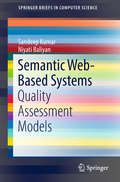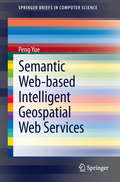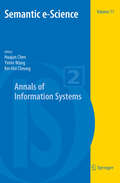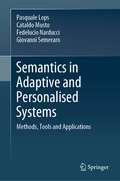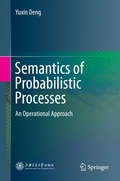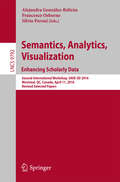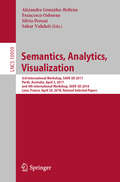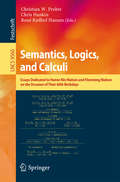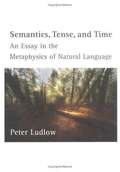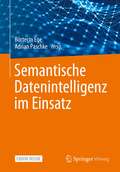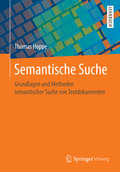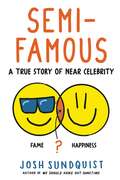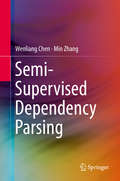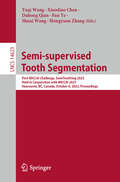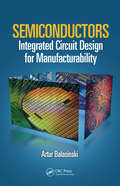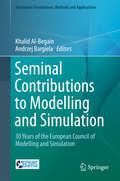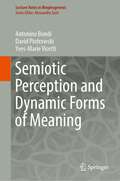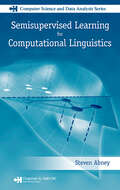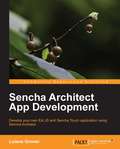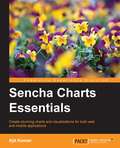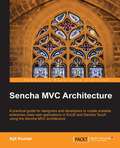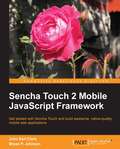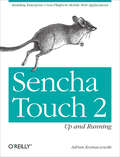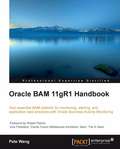- Table View
- List View
Semantic Web-Based Systems: Quality Assessment Models (SpringerBriefs in Computer Science)
by Sandeep Kumar Niyati BaliyanThe book initially presents the basic concepts related to the Semantic Web, Semantic Web-based applications, Web applications, Ontology, and their qualitative aspects. It then presents the evaluation of the structural quality of modular ontologies and review on metrics for the evaluation of ontology behavior.Further, the book discusses the qualitative evaluation of Semantic Web applications deployed on the Cloud, helping readers understand, maintain, integrate, and reuse these applications. The book offers software engineers in general and ontology engineers in particular a single, valuable guide to help them find the best modularization on the basis of goodness of (re) use. It can also serve as an initial source of information for starting research in this domain.
Semantic Web-based Intelligent Geospatial Web Services
by Peng YueBy introducing Semantic Web technologies into geospatial Web services, this book addresses the semantic description of geospatial data and standards-based Web services, discovery of geospatial data and services, and generation of composite services. Semantic descriptions for geospatial data, services, and geoprocessing service chains are structured, organized, and registered in geospatial catalogue services. The ontology-based approach helps to improve the recall and precision of data and services discovery. Semantics-enabled metadata tracking and satisfaction allows analysts to focus on the generation of a geospatial process model rather than spending large amounts of time in data preparation. "DataType"-driven service composition and path planning can help to automate a range of knowledge discovery processes in a limited geospatial domain. Process planning facilitates the construction of complex services and models for geocomputation. A three-phase procedure to cover the lifecycle of service chaining and to identify the roles of the methods involved is proposed. It includes process modeling, process model instantiation, and workflow execution. The approach is implemented in a prototype system with use cases to demonstrate applicability. The objective of the research is to develop the key technologies for an intelligent geospatial knowledge system based on Web services to automate the data discovery and data preprocessing steps in the distributed Web service environment, to automate a range of knowledge discovery processes in a limited geospatial domain, using the automated construction and execution of service chains, and to facilitate the construction of complex services and models for geocomputation.
Semantic e-Science
by Huajun Chen Kei-Hoi Cheung Yimin WangThe Semantic Web has been a very important development in how knowledge is disseminated and manipulated on the Web, but it has been of particular importance to the flow of scientific knowledge, and will continue to shape how data is stored and accessed in a broad range of disciplines, including life sciences, earth science, materials science, and the social sciences. After first presenting papers on the foundations of semantic e-science, including papers on scientific knowledge acquisition, data integration, and workflow, this volume looks at the state of the art in each of the above-mentioned disciplines, presenting research on semantic web applications in the life, earth, materials, and social sciences. Drawing papers from three semantic web workshops, as well as papers from several invited contributors, this volume illustrates how far semantic web applications have come in helping to manage scientific information flow.
Semantics in Adaptive and Personalised Systems: Methods, Tools and Applications
by Giovanni Semeraro Pasquale Lops Cataldo Musto Fedelucio NarducciThis monograph gives a complete overview of the techniques and the methods for semantics-aware content representation and shows how to apply such techniques in various use cases, such as recommender systems, user profiling and social media analysis. Throughout the book, the authors provide an extensive analysis of the techniques currently proposed in the literature and cover all the available tools and libraries to implement and exploit such methodologies in real-world scenarios. The book first introduces the problem of information overload and the reasons why content-based information needs to be taken into account. Next, the basics of Natural Language Processing are provided, by describing operations such as tokenization, stopword removal, lemmatization, stemming, part-of-speech tagging, along with the main problems and issues. Finally, the book describes the different approaches for semantics-aware content representation: such approaches are split into ‘exogenous’ and ‘endogenous’ ones, depending on whether external knowledge sources as DBpedia or geometrical models and distributional semantics are used, respectively. To conclude, several successful use cases and an extensive list of available tools and resources to implement the approaches are shown. Semantics in Adaptive and Personalised Systems definitely fills the gap between the extensive literature on content-based recommender systems, natural language processing, and the different types of semantics-aware representations.
Semantics of Probabilistic Processes
by Yuxin DengThis book discusses the semantic foundations of concurrent systems with nondeterministic and probabilistic behaviour. Particular attention is given to clarifying the relationship between testing and simulation semantics and characterising bisimulations from metric, logical, and algorithmic perspectives. Besides presenting recent research outcomes in probabilistic concurrency theory, the book exemplifies the use of many mathematical techniques to solve problems in computer science, which is intended to be accessible to postgraduate students in Computer Science and Mathematics. It can also be used by researchers and practitioners either for advanced study or for technical reference.
Semantics, Analytics, Visualization. Enhancing Scholarly Data
by Silvio Peroni Alejandra González-Beltrán Francesco OsborneThis book constitutes the refereed proceedings of the Second International Workshop on Semantics, Analytics, Visualization,- Enhancing Scholarly Data,- SAVE-SD 2016, held in Montreal, QC, Canada, in April 2016. The 5 full papers, 6 demo and poster papers and 2 position papers, were carefully reviewed and selected from 16 submissions. The papers are organized in two topical sections: "Extracting Knowledge from Research Publications" and "Semantic Technologies for Citation and Topic Analysis".
Semantics, Analytics, Visualization: 3rd International Workshop, Save-sd 2017, Perth, Australia, April 3, 2017, And 4th International Workshop, Save-sd 2018, Lyon, France, April 24, 2018, Revised Selected Papers (Lecture Notes in Computer Science #10959)
by Silvio Peroni Alejandra González-Beltrán Francesco Osborne Sahar VahdatiThis book constitutes the refereed proceedings of the 3rd International Workshop, SAVE-SD 2017, held in Perth, Australia, in April 2017, and the 4th International Workshop, SAVE-SD 2018, held in Lyon, France, in April 2018. The 6 full, 2 position and 4 short papers were selected from 16 submissions. The papers describe multiple ways in which scholarly dissemination can be approved: Creating structured data, providing methods for semantic computational analysis and designing systems for navigating. This allows a variety of stakeholders to understand research dynamics, predict trends and evaluate the quality of research.
Semantics, Logics, and Calculi
by Christian W. Probst Chris Hankin René Rydhof HansenThis Festschrift volume is published in honorof Hanne Riis Nielson and Flemming Nielson on the occasion of their 60thbirthdays in 2014 and 2015, respectively. The papers included in this volumedeal with the wide area of calculi, semantics, and analysis. The book features contributions fromcolleagues, who have worked together with Hanne and Flemming through theirscientific life and are dedicated to them and to their work. The papers werepresented at a colloquium at the Technical University of Denmark in January2016.
Semantics, Tense, and Time: An Essay in the Metaphysics of Natural Language
by Peter LudlowOne of the central goals of this book is to illustrate how one can study metaphysical questions from a linguistic/semantical perspective. The specific issue that the author has chosen to investigate is the well-entrenched dispute between A-theorists and B-theorists about the nature of time.
Semantische Datenintelligenz im Einsatz
by Adrian Paschke Börteçin EgeSemantische Technologien haben mit der Entwicklung von datenbasierten Systemen wie Neuronale Netze, Deep Learning und Machine Learning ihre Bedeutung nicht verloren, sondern werden als effiziente wissensbasierte Systeme immer wichtiger. Denn intelligente Systeme der Zukunft müssen nicht nur in der Lage sein zu sagen, was sie entschieden haben, sondern auch wie sie zu dieser Entscheidung gekommen sind. Solche Systeme sind jedoch nur mit Hilfe von wissensbasierten Systemen auf der Grundlage von semantischen Technologien erreichbar. Heute reichen die Anwendungen von semantischen Systemen von der semantischen Suche, Knowledge Graphs, Chatbots, NLP, in der Medizin bis zur Telekommunikation, Verwaltung und Robotik. Semantische Technologien werden spätestens mit dem Voranschreiten des Internet of Things (IoT) und Industrie 4.0 Anwendungen allgegenwärtig sein. Dies ist unumgänglich, denn ohne sie ist auch die Interoperabilität unter Maschinen und insbesondere unter Roboter für eine intelligente Zusammenarbeit und Produktion nicht so einfach umsetzbar. Dafür gibt es bereits heute zahlreiche Beispiele aus der Industrie.
Semantische Suche: Grundlagen und Methoden semantischer Suche von Textdokumenten
by Thomas HoppeSemantische Suchverfahren kombinieren Techniken der Textverarbeitung, des Information Retrievals und der Wissensverarbeitung, um Informationssuchenden bessere Suchergebnisse als reine Volltextsuchen zu liefern und die Sprachbarriere zu den Autoren zu überbrücken. Dieses Buch zeigt, wie Komponenten intelligenter Suchverfahren mit diesen Techniken umgesetzt werden und zu unterschiedlichen Extra- und Intranet-Suchmaschinen kombiniert werden können. Hierbei wird der Schwerpunkt auf die Grundlagen und Konstruktionsprinzipien von Verfahren zur semantischen Suche in Texten gelegt. Mit vielen Praxisbeispielen, praktischen Erfahrungen, Aufgaben und Lösungen ist das Buch sowohl für Studierende und Dozenten als auch für Entwickler, Produkt- und Projektmanager und Entscheider bestens geeignet.
Semblance and Event: Activist Philosophy and the Occurrent Arts (Technologies of Lived Abstraction)
by Brian MassumiAn investigation of the “occurrent arts” through the concepts of the “semblance” and “lived abstraction.”Events are always passing; to experience an event is to experience the passing. But how do we perceive an experience that encompasses the just-was and the is-about-to-be as much as what is actually present? In Semblance and Event, Brian Massumi, drawing on the work of William James, Alfred North Whitehead, Gilles Deleuze, and others, develops the concept of “semblance” as a way to approach this question. It is, he argues, a question of abstraction, not as the opposite of the concrete but as a dimension of it: “lived abstraction.” A semblance is a lived abstraction. Massumi uses the category of the semblance to investigate practices of art that are relational and event-oriented—variously known as interactive art, ephemeral art, performance art, art intervention—which he refers to collectively as the “occurrent arts.” Each art practice invents its own kinds of relational events of lived abstraction, to produce a signature species of semblance. The artwork's relational engagement, Massumi continues, gives it a political valence just as necessary and immediate as the aesthetic dimension.
Semi-Famous: A True Story of Near Celebrity
by Josh SundquistIn this "laugh-out-loud funny&” book (Hank Green, New York Times bestselling author), social media star and comedian Josh Sundquist takes readers on his hilarious journey to the fringes of viral stardom to discover if it&’s possible to be both very famous and very happy As a semi-famous internet creator, Josh Sundquist knows what it's like to chase fame, but he also knows that more fame usually means more stress. So he set out on a pseudo-scientific investigation to find out if there is any way for fame and happiness to overlap. He attempts to define the word &“fame&”—hint: it's harder than you'd think. He turns back time to identify the first facially-recognizable celebrity (you might know his former BFF Brutus). He digs into the numbers to debunk urban legends associated with stardom (ever heard of the 27 Club?). He talks to other semi-famous people (from K-pop sensations to former child stars) and asks them: Is this fame thing making you happy? If not, why are you doing it? If so, what's your secret? All while recounting funny stories about his own cringy fame-seeking (like his many attempts, and failures, to get onto MTV). Packed with playful diagrams, fascinating insights from celebrities, and embarrassing truths from Josh&’s experience with semi-fame, this is a must-read for anyone who has ever dreamed of becoming famous…or at least going viral on TikTok.
Semi-Supervised Dependency Parsing
by Min Zhang Wenliang ChenThis book presents a comprehensive overview of semi-supervised approaches to dependency parsing. Having become increasingly popular in recent years, one of the main reasons for their success is that they can make use of large unlabeled data together with relatively small labeled data and have shown their advantages in the context of dependency parsing for many languages. Various semi-supervised dependency parsing approaches have been proposed in recent works which utilize different types of information gleaned from unlabeled data. The book offers readers a comprehensive introduction to these approaches, making it ideally suited as a textbook for advanced undergraduate and graduate students and researchers in the fields of syntactic parsing and natural language processing.
Semi-supervised Tooth Segmentation: First MICCAI Challenge, SemiToothSeg 2023, Held in Conjunction with MICCAI 2023, Vancouver, BC, Canada, October 8, 2023, Proceedings (Lecture Notes in Computer Science #14623)
by Fan Ye Shuai Wang Yaqi Wang Xiaodiao Chen Dahong Qian Hongyuan ZhangThis book constitutes the proceedings of the First MICCAI 2023 Challenge on Semi-supervised Tooth Segmentation, SemiToothSeg 2023, held in Conjunction with MICCAI 2023, in Vancouver, BC, Canada, on October 8, 2023. The 16 full papers presented in this book were carefully reviewed and selected from 64 submissions. The papers were written by participants in the STS challenge to describe their solutions for automatic teeth segmentation using the offcial training dataset released for this purpose. In general, this challenge aims to promote the development of the teeth segmentation in panoramic X-ray images and dental CBCT scans.
Semiconductors: Integrated Circuit Design for Manufacturability (Devices, Circuits, and Systems)
by Artur BalasinskiBecause of the continuous evolution of integrated circuit manufacturing (ICM) and design for manufacturability (DfM), most books on the subject are obsolete before they even go to press. That’s why the field requires a reference that takes the focus off of numbers and concentrates more on larger economic concepts than on technical details. Semiconductors: Integrated Circuit Design for Manufacturability covers the gradual evolution of integrated circuit design (ICD) as a basis to propose strategies for improving return-on-investment (ROI) for ICD in manufacturing. Where most books put the spotlight on detailed engineering enhancements and their implications for device functionality, in contrast, this one offers, among other things, crucial, valuable historical background and roadmapping, all illustrated with examples. Presents actual test cases that illustrate product challenges, examine possible solution strategies, and demonstrate how to select and implement the right one This book shows that DfM is a powerful generic engineering concept with potential extending beyond its usual application in automated layout enhancements centered on proximity correction and pattern density. This material explores the concept of ICD for production by breaking down its major steps: product definition, design, layout, and manufacturing. Averting extended discussion of technology, techniques, or specific device dimensions, the author also avoids the clumsy chapter architecture that can hinder other books on this subject. The result is an extremely functional, systematic presentation that simplifies existing approaches to DfM, outlining a clear set of criteria to help readers assess reliability, functionality, and yield. With careful consideration of the economic and technical trade-offs involved in ICD for manufacturing, this reference addresses techniques for physical, electrical, and logical design, keeping coverage fresh and concise for the designers, manufacturers, and researchers defining product architecture and research programs.
Seminal Contributions to Modelling and Simulation
by Khalid Al-Begain Andrzej BargielaMarking the 30th anniversary of the European Conference on Modelling and Simulation (ECMS), this inspirational text/reference reviews significant advances in the field of modelling and simulation, as well as key applications of simulation in other disciplines. The broad-ranging volume presents contributions from a varied selection of distinguished experts chosen from high-impact keynote speakers and best paper winners from the conference, including a Nobel Prize recipient, and the first president of the European Council for Modelling and Simulation (also abbreviated to ECMS). This authoritative book will be of great value to all researchers working in the field of modelling and simulation, in addition to scientists from other disciplines who make use of modelling and simulation approaches in their work.
Semiotic Perception and Dynamic Forms of Meaning (Lecture Notes in Morphogenesis)
by David Piotrowski Antonino Bondi Yves-Marie VisettiWhat do we mean by semiotic perception? Why should the concepts of perception and expressivity be reinterpreted within the encompassing framework of a dynamic theory of semiotic fields and forms? Can we redeploy the concept of form in such a way as to make explicit such a native solidarity (‘chiasmatic’ would have said Merleau-Ponty) between perception, praxis and expression -- and first and foremost in the activity of language, right to the heart of the life of the social and speaking animal that we are? What then would be the epistemological and ontological consequences, and how might this affect the way we describe semiolinguistic forms? This book aims to provide answers to these questions by opening up avenues of research on how to understand the linguistic and semiotic dimensions at work in the constitution of experience, both individual and collective.
Semisupervised Learning for Computational Linguistics (Chapman & Hall/CRC Computer Science & Data Analysis)
by Steven AbneyThe rapid advancement in the theoretical understanding of statistical and machine learning methods for semisupervised learning has made it difficult for nonspecialists to keep up to date in the field. Providing a broad, accessible treatment of the theory as well as linguistic applications, Semisupervised Learning for Computational Linguistics offer
Sencha Architect App Development
by Loiane GronerA standard tutorial-based approach for using Sencha Architect to develop applications in Ext JS and Sencha Touch.Sencha Architect App Development is for Ext JS and Sencha Touch developers that are looking to improve their productivity by using Sencha Architect for app development. Basic knowledge of Ext JS and Sencha Touch is required.
Sencha Charts Essentials
by Ajit KumarIf you are an Ext JS or Sencha Touch developer, designer, or architect who wants to build enterprise-scale data visualization capabilities using Sencha, then this book is ideal for you. You should have a knowledge of HTML, JavaScript, CSS, and Sencha Ext JS or Sencha Touch fundamentals, in particular. Some familiarity with SVG and HTML5 Canvas would be preferred, but not required.
Sencha MVC Architecture
by Ajit KumarThis is a step-by-step tutorial with plenty of example code for easier and quicker pick-up. If you are new to ExtJS or Sencha Touch, this book will help you model your application using good architectural practices so that your application is enterprise-class from day one. If you have already been building ExtJS or Sencha Touch based applications, this book will show you how to apply the client-side MVC architecture and benefit from it. It will show you how you can leverage Sencha's MVC Architecture and the Sencha Tools to manage your projects in a better way.
Sencha Touch 2 Mobile JavaScript Framework
by Bryan P. Johnson John Earl ClarkFull of explained code and enriched with screenshots, this book is the practical way to take your Sencha Touch skills to the next level.If you want to gain practical knowledge for using the Sencha Touch mobile web application framework, and you are familiar with HTML and CSS, then this book is for you. It is assumed that you know how to use touchscreens, touch events, and mobile devices such as Apple iOS and Google Android.
Sencha Touch 2 Up and Running: Building Enterprise Cross-Platform Mobile Web Applications
by Adrian KosmaczewskiLaunch into Sencha Touch 2 with this hands-on book, and quickly learn how to develop robust mobile web apps that look and behave like native applications. Using numerous code samples, author Adrian Kosmaczewski guides you every step of the way through this touchscreen-enabled JavaScript framework—from creating your first basic app to debugging, testing, and deploying a finished product. Learn how to craft user interfaces, build forms, and manage data, then deploy as either an HTML5 offline app or as a native app for Android, iOS, or Blackberry.Define classes and create instances with Sencha Touch’s object-oriented abstractionBuild user interfaces with the framework’s extensive set of high-level componentsDevelop apps that consume complex data, whether it’s stored locally or on remote serversOrganize your application code in a consistent, predictable, and maintainable wayUse Sass stylesheets to craft a personalized look and feel for your appDebug, test, and document your app with WebKit Web Inspector, Jasmine, Siesta, and JSDuckUse the Sencha Architect UI designer and IDE to simplify complex project development
Sencha Touch Cookbook
by Ajit KumarThe book is written in a cookbook style, presenting examples in the style of recipes, allowing you to go directly to your topic of interest, or follow topics throughout a chapter to gain in-depth knowledge. This book is ideal for anyone who wants to gain the practical knowledge involved in using Sencha Touch mobile web application framework to make attractive web apps for mobiles. If you have some familiarity with HTML and CSS, then this book is for you. This book will give designers the skills they need to implement their ideas, and provide developers with creative inspiration through practical examples. It is assumed that you know how to use touch screens, touch events, WebKit on mobile systems, Apple iOS, and Google Android for Mobiles.
